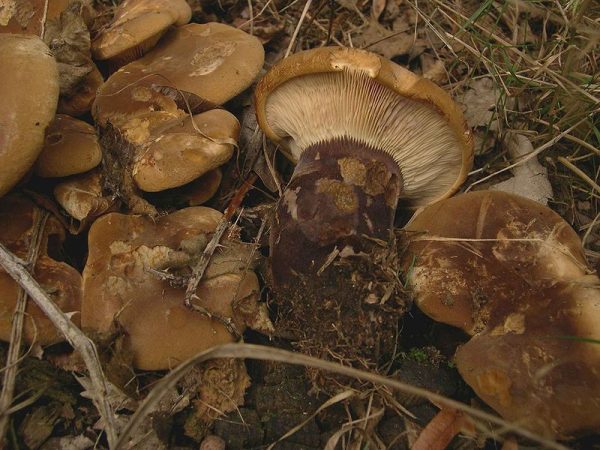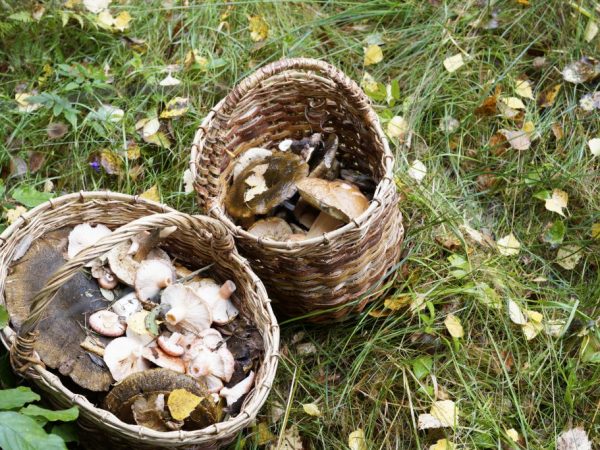The pig is fat
Pigs are a small genus of mushrooms belonging to the Pig family of the order Boletovye in which there are edible and poisonous representatives. They live in new deciduous or coniferous forests. The fat pig is one of the poisonous representatives of the family, which is also called the felt pig.

The pig is fat
Description of the appearance of the mushroom
The Svinushka genus combines the types of hat-footed structure. However, in some of them, the stem can be reduced, as a result of which the caps sit directly on the substrate. Legs are central or eccentric. Descending plates, connecting at the leg (anastomosing), easily separated from the cap. The edge of the cap is often wrapped, especially in young specimens. Spores are smooth, brown, buffy or dirty yellow.
A fat pig is a mushroom with a large brown or dark red cap, the diameter of which, although it normally fluctuates within 12-20 cm, can reach, although in rare cases, 30 cm.The surface is rough, felt, with a slight velvety. In the process of development, the cap becomes dry and bare, small cracks form on it. A young mushroom is characterized by a round shape of the cap, which changes with growth and becomes disproportionate with wavy edges. The plates of the hymenophore are yellow, descending, branched and connected at the base (at the leg).
The plates of the hymenophore of the thick pig have a light yellow color. If you press on them, they will darken. Brown-brown spore powder. The plates descend to the stem, which is very clearly visible in the mushroom.
The fat pig has a massive and dense leg, the height of which does not exceed 10 cm. Its surface is covered with a velvet, felt bloom. The species is characterized by the fact that the leg does not melt from the center of the cap, but is shifted to its edge. This type of cap is called "side".
The thick pig mushroom pulp does not have an expressive smell, and also has a bitter and tart aftertaste. There is a lot of yellow liquid inside.
Irina Selyutina (Biologist):
Specific features of the thick pig:
- Upon contact of the cap and leg with ammonia (NH3H2O or NH4OH), their surface is painted in a bright lilac color.
- When a solution of caustic potassium or potassium hydroxide (KOH) is applied to the pulp, it turns green-black.
- The pulp is hygrophilous, as a result of which liquid accumulates in it.
- The fruiting bodies contain:
- atromentin: brown pigment with antibiotic properties;
- tephoric acid: a blue pigment that can be used to dye wool products (or wool itself) bluish.
The fungus grows near the trunks, stumps and roots of conifers (pine) and deciduous trees. The fruiting period lasts from mid-July to early October. Dwells in small groups.
Differences from similar varieties
The main distinguishing feature of Fat Pig is velvety on leg. The hat has a similar description to the Polish mushroom or the green moss mushroom, but these mushrooms belong to the tubular group and are edible.
Differences between a fat pig and a thin one:
- Climate: fat pig is common only in temperate climates.
- Place of growth: the fat pig grows only near trees or stumps.
- Fruiting period: the slender pig begins to bear fruit in mid-May.
- Leg shape: for a slender pig, a cylindrical leg is characteristic.
- The size: the diameter of the leg of a thin pig does not exceed 3-4 cm, and the height is 8 cm.
The poisonousness of the fat pig
Fat pig is a poisonous mushroom. Previously, it was considered conditionally edible, but cases of its poisoning have been recorded. In addition to the tough and bitter pulp, the fat pig is characterized by the presence of poisonous substances in the composition, which are not destroyed by prolonged exposure to high temperatures. Also, the composition contains heavy metals and copper isotopes, which negatively affect the gastrointestinal tract.
Harmful substances contained in plump pig:
- muscarine;
- specific antigens;
- lectin.
These substances cause severe poisoning. When an antigen enters the body, antibodies are produced, which accumulate in the blood and cause its disease. Lectin and muscarine accumulate in the body, negatively affecting it, and do not come out naturally.
On a note. Back in 1981, the pigs are thick on a par with the village. thin, were excluded from the list of mushrooms allowed for harvesting, processing and sale throughout the USSR.
Also, the consumption of the mushroom causes the destruction of red blood cells - erythrocytes, which reduces the level of hemoglobin. This causes anemia and jaundice. In case of severe poisoning, death is possible.
Poisoning symptoms
The main symptom of poisoning is muscarinic syndrome. It manifests itself within an hour after eating the mushroom.
Description of the syndrome:
- heavy sweating;
- headache;
- nausea;
- feeling weak and tired;
- high salivation;
- lowering blood pressure.
In the absence of first aid, poisoning causes disruption of the gastrointestinal tract. They manifest in loose stools and abdominal pain (cuts). If a large amount of toxic substances enter the body, there is a risk of edema of the brain and lungs.
Symptoms of poisoning do not appear if you eat a small amount of the product. But poisonous substances from mushrooms are gradually deposited in the body and cause permanent harm to internal organs. Lectins help accelerate blood clotting, which causes cardiovascular disease.
Treatment for poisoning
An ambulance is required to be called as soon as the first symptoms of poisoning appear. Before the arrival of the doctors, the patient is given plenty of fluids to drink. Strong herbal tea without sugar or purified (filtered) water at room temperature has a good effect. This allows you to empty the stomach and remove more toxic substances.
To stimulate the release of toxic substances from the body, the following means are used:
- Smecta;
- Enterosorbent;
- Enterosgel;
- activated carbon (1 tablet per 10 kg of mass).
In case of severe poisoning, a laxative or enema helps. This significantly increases the release of harmful substances from the stomach.

Strong herbal tea without sugar helps with poisoning
Attention! When providing first aid, it is strictly forbidden:
- Take means that improve (fasten) the work of the gastrointestinal tract (digestive disorders will delay the ingress of poison into the blood).
- Give enemas to older people.
- Induce the gag reflex in children under 3 years of age and in pregnant women.
A group of doctors called in is hospitalizing a patient who has been poisoned by mushrooms. In a medical institution, he is prescribed medication detoxification.The type of procedure depends on the volume of toxic substances in the body, as well as the physiological characteristics of the patient. Advice. Save leftover food with mushrooms that caused the poisoning for laboratory testing.
Detoxification methods:
- gastric lavage;
- hemodialysis;
- enema.
Recovery from poisoning
After detoxification, the patient is restored to the water and electrolyte (salt) balance in the body (one can say that the water-salt balance is restored). For this, antibiotics are used in the form of tablets, injections. In acute cases of mushroom poisoning, droppers are placed. For recovery, the patient is prescribed a special diet.
Nutrition rules after poisoning with a fat pig:
- you can not eat fried, smoked, fatty and spicy foods;
- refusal from alcohol and cigarettes;
- eating boiled or steamed food;
- you can only eat chopped fruits and vegetables.
Conclusion
Fat pig is a rare fungus that is not suitable for human consumption. Eating these mushrooms can cause a number of problems, including blood problems. To avoid this, it is necessary to carefully examine the mushrooms at the collection site, not to collect unfamiliar or unfamiliar species. It is best for a novice mushroom picker to turn to the seasoned lovers of "quiet hunting" with their harvest upon their return from the forest, with a request to revise what they have collected.



